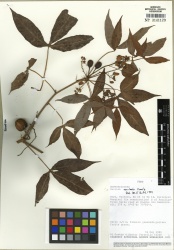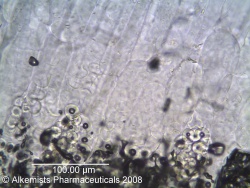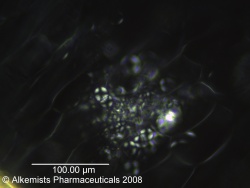|
AHPA recognizes other valuable resources exist regarding the identity of Manihot esculenta.
To submit a suggestion or contribution, please contact Merle Zimmermann.
|
Nomenclature
Manihot esculenta Crantz Euphorbiaceae
Syn. Janipha manihot (L.) Kunth; Jatropha manihot L.
Standardized common name (English): cassava
Botanical Voucher Specimen
 |
|

Source: MOBOT, Tropicos.org[1]
|
Organoleptic Characteristics
Macroscopic Characteristics
| Tapioca is in irregular, hard, white, rough grains, possessing little taste, partially soluble in cold water, and affording a fine blue color when iodine is added to its filtered solution. The partial solubility in cold water is owing to the rupture of the starch granules by heat.
Source: United States Dispensatory (1918) [2]
|
|
|
|
|
Microscopic Characteristics
| Examined under the microscope, the granules appear somewhat plano-convex or bell-shaped and more or less compound. The individual grains vary from 0.006 to 0.030 mm. in diameter and have a distinct central circular or radiating cleft. They polarize light strongly, showing a distinct cross.
Source: United States Dispensatory (1918) [3]
|
|
|
|
|
High Performance Thin Layer Chromatographic Identification
Supplementary Information
Sources
- ↑ MOBOT, Tropicos.org http://www.tropicos.org/Image/100000722
- ↑ United States Dispensatory (1918)
- ↑ United States Dispensatory (1918)
- ↑ Elan M. Sudberg, Alkemist Laboratories http://www.alkemist.com
- ↑ Elan M. Sudberg, Alkemist Laboratories http://www.alkemist.com



